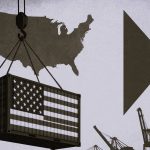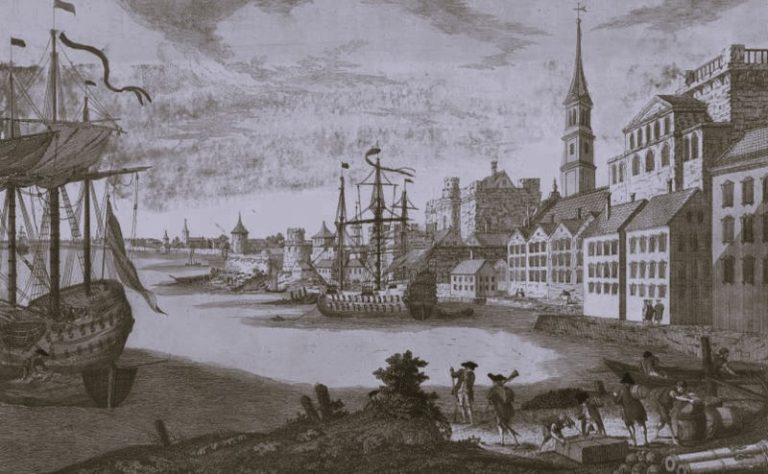A combination of poverty and “plague orders” in 1665 trapped many in situations that meant almost certain infection and death. Weaver John New, like many confined with dying relatives, was denied the escape routes open to the rich.
By Anna Faherty / 06.22.2017
Associate Lecturer
University of the Arts London
The City of London, 1665. As the Great Plague hits the capital, John New faces a deadly dilemma.
Victims of the 1665 plague are lifted onto a death cart, Samuel Wale, 1747 / Wellcome Collection, Creative Commons
On 6 August 1665, New, a weaver in the bustling London parish of Cripplegate, watched his son and daughter die from what local broadsheets were already calling “The Great Plague”. The latest outbreak of this fearful disease, and the efforts taken to control its spread through one of Europe’s largest commercial centres, struck weavers like New, as well as other artisans and tradespeople, particularly hard.
Hours or days before, New would have spotted painful black swellings, known as buboes, around the groins, armpits or necks of his children. Such was the fear of plague spreading through the city that symptoms like this had to be reported to the authorities within just two hours. The children would have soon experienced headaches, vomiting and pain so intense that many victims were overcome with frenzy. Their swellings would have turned red, purple or black and may have ruptured to form open sores. The only mercy for New and his family was that death – a near certainty – came quickly.
Despite published precautions and remedies, the only sure way to avoid this fate – which appeared to befall rich and poor alike – was to leave the city. New would have had plenty of time to consider this course of action. It’s possible he would have heard about the spreading “contagion” two months before, when the first weaver in Cripplegate died from the disease and the city’s playhouses closed. A month later the Lord Mayor issued orders designed to control the infection and, by the middle of June, New couldn’t have failed to notice that Londoners were fleeing the city in droves.
People fleeing the plague, first printed 1630 / Wellcome Collection, Creative Commons
Even after a hundred local people involved in his trade had died, and the Bishop of London had announced that “many thousands of poore Artisans” were on the brink of starvation due to lack of business, New remained in the pestilential city. In fact, though diarist Samuel Pepys claimed “all the towne” was leaving, tradespeople like New, and the city’s poorest inhabitants, had little option but to stay.
[LEFT]: A London street during the 1665 plague, J Jellicoe, 19th century / Wellcome Collection, Creative Commons
[RIGHT]: A terrified man realising he has contracted the plague, Edward Ward, 1848 / Wellcome Collection, Creative Commons
The 1665 plague in London, Walter George Bell, 1924 / Wellcome Collection, Creative Commons
[LEFT]: A London street during the 1665 plague, George Cruikshank, 19th century / Wellcome Collection, Creative Commons
[CENTER]: A man in rags announcing the forthcoming doom during London’s 1665 plague, Arthur Frost, 19th century / Wellcome Collection, Creative Commons
[RIGHT]: Solomon Eagle carrying coals on his head to fumigate London’s air during the 1665 plague, Edward Ward, 1848 / Wellcome Collection, Creative Commons
Two dead women lying in a London street during the 1665 plague, Robert Pollard, 18th or 19th century / Wellcome Collection, Creative Commons
The well-to-do, like the poet John Dryden – who retired to his father-in-law’s estate in the West Country – and many of London’s physicians, had the means to pay for transport out of the sick city. They left their servants to watch over their expensive properties and were easily able to support themselves for an extended stay away from London.
New would have struggled to find the five-shilling fare for the cheapest wagon out of town. He also would have risked losing his livelihood if he left, since his home (which may have doubled as his place of work) might be ransacked in his absence, resulting in the loss of both goods and tools. Leaving the city would have removed any chance of keeping his business alive. However, staying wouldn’t do much for trade, due to controls placed on the movement of goods and people both before and during the outbreak.
Two years earlier the Privy Council – a small group of men who governed England under King Charles II – had taken action when the plague arrived in Amsterdam. The Royal Navy had intercepted ships in the Thames estuary and asked any vessels from Amsterdam to either turn back or anchor at the remote Canvey Island. There, cargoes were unloaded and aired for 30 days. Crew and passengers had to stay aboard for the same amount of time.
In the early summer of 1664, as deaths in Amsterdam rose, ships from all Dutch ports were held outside London for 40 days, a period known as ‘quarantine’, from the Italian word for 40. Though measures to separate the sick from the healthy had been used to limit – with varying levels of impact – the spread of infectious disease in many countries and periods, London’s approach to plague control was based on a concept first developed in Italy.
[LEFT]: A medical officer inspecting the crew of a ship in the Thames for plague, F de Haanen, 1905 / Wellcome Collection, Creative Commons
[CENTER]: A ship in Brindisi, Italy during a quarantine examination for cholera, Italy, 1883 / Wellcome Collection, Creative Commons
[RIGHT]: A plan for a lazaretto or isolation hospital, John Howard, 1789 / Wellcome Collection, Creative Commons
Ships at Deptford, London that were used for smallpox patients, 1881 / Wellcome Collection, Creative Commons
Ships at Deptford, London that were used for smallpox patients, 1881 / Wellcome Collection, Creative Commons
The quarantine station on St John’s Island, Malaysia, John Edmund Taylor, 1879 / Wellcome Collection, Creative Commons
The Health Office at Naples, Italy, John Howard, 1789 / Wellcome Collection, Creative Commons
The pest house, a hospital for people suffering from plague, at Leiden, the Netherlands / Wellcome Collection, Creative Commons
A yellow fever isolation ward in Rio de Janeiro, Brazil, Oswaldo Cruz, 1909 / Wellcome Collection, Creative Commons
Growing out of the thinking of Florentine scholars and lawyers in the 1400s, the “ideology of order” viewed society as a living organism that needed hierarchy and stability to survive. City authorities could therefore justify imposing draconian measures, which disrupted the lives of ordinary people, during periods of crisis, such as epidemics.
The Thames shipping controls appeared to work – at first. During 1664 over 24,000 people died from plague in Amsterdam, while only five cases were reported in London. When the disease finally hit the English city, the Lord Mayor’s plague orders meant anyone wanting to leave required a health certificate. Those with the money to bribe officials would find it easier to obtain one than tradespeople like New.
Plague orders published by the Lord Mayor and Aldermen of the City of London, 1665 / Wellcome Collection, Creative Commons
The orders required householders to clean the street outside their home every day and insisted that burials only take place at night – with neither family nor friends present. No dogs, cats, rabbits or pigeons were allowed in the city, and businesses that involved travel or gatherings of people had to stop operating. Ale and coffee houses closed down, as did markets, theatres and other social spaces. Street sellers and hawkers were prohibited from selling any goods and all trade in second-hand clothes was banned.
Across the city, official examiners and searchers were appointed “to inquire and learn” which homes had been “visited” by illness and to identify those affected by plague. These houses were then shut up for 28 days, complete with all their inhabitants – whether infected or not. Plague homes were marked by a foot-high red cross on their doors and the words “Lord have mercy on us”. Watchmen supplied the inhabitants with food, while ensuring none of them left the property. Nurses could be provided at the cost of the parish.
The practice of shutting up the healthy alongside the sick was unique to England. Local writer Daniel Defoe, aged just six at the time, later described “the confining the Sound in the same House with the Sick” as “a great Subject of Discontent”. Unsurprisingly the practice prompted many complaints. Shutting up was variously thought to cause more disease, bring on a melancholy that made one more susceptible to it, obstruct trade and add to the demands on parish budgets, which now had to support both the well and the sick.
What officials attempting to stop the spread of plague didn’t know at the time was that it is very rarely transmitted from human to human. Plague is caused by a bacterium that usually infects small rodents, including black rats. When one of these rats dies, fleas feeding on its blood will move to the next best thing – in a shut-up house, this could be the nearest human, who might otherwise have been spared.
A black rat, William Samuel Howitt, 1808 / Wellcome Collection, Creative Commons
As the number of infected people in the city grew, it became difficult to police the shutting up of houses. By the time New’s children became ill, anyone who did not comply with the plague orders could be legally restrained, though some ‘inmates’ still managed to escape. Meanwhile, many of those in the upper echelons of society simply ignored the rules. Neighbours of the Lord Mayor himself were arrested when they tried to shut up his house, which became infected in September.
Even citizens free to move around the deserted city changed their behaviour. People walked in the middle of the street to avoid contact with others, only entered shops if no other customers were present, and preferred not to handle money. All this clearly affected trade. Those involved in cloth-making were, perhaps, worst affected, since plague was thought to be transmitted by the movement of fabrics. In hindsight this has some truth: fleas can survive for several weeks outside a living host and might easily be moved around – and out of – the city within bundles of cloth.
In this climate, John New’s life would have been strained even without the pain of losing his children. As it was, he didn’t have to struggle through the worst days of the crisis, which arrived later in August and September. New died just three days after his children, one of an estimated 100,000 people who perished before the end of October, when cooler weather arrived and London’s most recent epidemic subsided.
Originally published by Wellcome Library under a Creative Commons Attribution 4.0 International license.





























